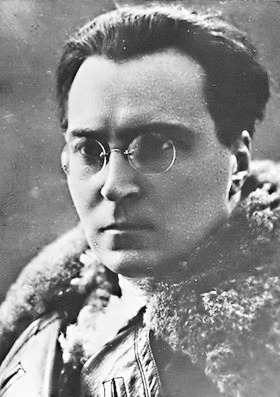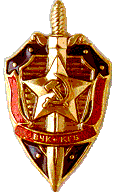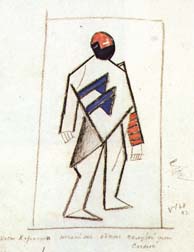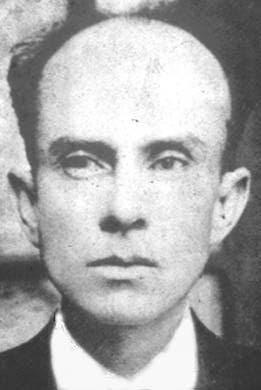Red Babel
How the Russian Empire became the Sovetunio (1997)
Comrades, we stand at a crossroad in history. Uprisings threaten the remaining European Empires and we have to respond to the changing tides of power. Unfortunately some of us lost the ability to reason, to compromise to see the shades of grey in what they perceive as literal battle of black against white. When we ask ourselves what it means to be an Internationalist Socialist, we need to look back at our party's founder Trotsky. Yes, he was a man of adamant ideals, but he was capable of understanding and articulating nuances in his political stances. There is a crucial difference between visionary socialist leaders like Shripad Dange and tribal warlords that spout some catchphrases they took form quickly skipping the Socialist ABC. Obviously every one of us knows why imperialism is "bad", but a look at our own history shows that things aren't always that simple.
Red Babel: How the Russian Empire became the Sovetunio
Imperialism can indeed take beneficial forms. When the Bolsheviks came to power in November 1917, they took possession of a disintegrating multiethnic state with quite strong nationalist movements on its western and southern peripheries, weaker ones in the east, and a relatively undeveloped but potentially most dangerous consciousness among the central and numerically dominant Russians. Both Trotsky as well as Bogdanov were very impressed by the collapse of the Austro-Hungarian and Ottoman Empire and agreed, particularly after three years of the bitter Class War , that the nationalist threat was indeed a serious one. In their eyes Russian nationalism was the most serious threat to state unity, since it could provoke defensive nationalism among the non-Russians population. Therefore, their self-consciously attempted to create an anti-imperial state that would later be unified by the emerging proletarian culture which would dissolve all other identities. Until this point could be reached a solution for the transition period had to be found. This solution had to allow to curb any Great Russian chauvinism while at the same time allow the establishment for a new lingua franca in the empire. Obviously Russification, like the czar had done so far couldn’t be that solution. In the end the party decided to make Lingvo Internacia the new “national” language and at the same time preserve all minority languages as a counterbalance to any attempts of Russian cultural dominance. The socialist policy towards the minority nationalities after the Revolution, became known as ethnizatsiia (ethnization), which was designed to unite all the people of the USS into a single socialist community with a uniform national culture but diverse ethnicity. One aspect of this was the language policy, implemented by the Commissariat of Enlightenment, established in 1917 to serve as an intermediary between the central soveta organs and address such problems as standardizing each local language, spreading Lingvo Internacia as the common language of communication within the population, changing the lexicon to meet the needs of a modern industrial society, increasing literacy and creating new alphabets.
1. The Affirmative Action Empire
One of the things the new conciliating nation needed was a new proletarian political elite. This new elite was desired to be as ethnical diverse as possible. The US political analyst Mark Grove coined the term "affirmative action empire." which although very polemic still describes rather accurately what kind of nation was forming at the time.
“Affirmative action” is a new buzzword in Washington that refers to laws that shall accomplish non-discrimination. The term "Empire" should be self evident.
The Bolshevik government supported the creation and development of non-Russian elites, languages, and cultural institutions, while systematically downplaying and even “scapegoating” Russian national institutions and culture.
As Bukharin stated this fact rather bluntly: "As the former Great Power nation, we should indulge the national aspirations of the non-Russians and place ourselves in an unequal position, in the sense of making still greater concessions to minorities of our new nation. Only by such a policy, when we place ourselves artificially in a position lower in comparisons with others, only by such a price can we purchase for ourselves the trust of the formerly oppressed ethnicities."
This strategy defused nationalism and allowed to build a centralized, highly interventionist, multiethnic socialist state. We kept the cultural artefact of “ethnicity” that can be found in all empires but reversed the traditional ethnic hierarchy that placed the "state-bearing" ethnicity's prestige far above those of the "colonial" peoples. Again obviously this terminology, especially the word “empire” has certain negative connotations but at the same time these terms allow the highest accuracy of description. We after all used explicit terms like "culturally backward eastern regions" that were “in need for intensified cultural development”. The project of helping "develop" so called "backwards" colonial cultures is undeniably a typical late-imperial move to justify (not necessarily wrongly) modern empires in the age of nationalism.
Late “imperial” policies are not inherently negative, not when they are perused by a vastly more enlightened state to uplift primitive societies. Today's British (Capitalist) Empire's rule is still preferable to self governance of the pre-feudal tribal people in Africa, unlike India which gained independence with an intact bureaucratic infrastructure and a truly socialist intelligentsia.
The situation between the early days of the Sovetunio and the Empires in Africa is only different when it comes to the states of development. While parts of the Sovetunio reached the highest form of Enlightenment up to date, namely Socialism, many parts of the nation were still de facto stuck in the medieval ages. In the same sense today's European Empires may be capitalist but most parts of sub Saharan Africa are still stuck in the Stone Age.
An example for enlightened internal colonialism in the Sovetunio would be Uzbekistan, where the gender relations and customs of female seclusion, were correctly identified as backward and oppressive. Modernizing meant to eradicate precisely those social practices, that albeit fundamental parts of the Uzbek ethnic-cultural identity, were deeply inhuman and not tolerable. In the end the only thing left of the Uzbek culture was their language and rightly so. Unfortunately too many member of our party would probably decry our founders work as horrible chauvinism and romanticize the appallingly primitive indigenous cultures.
Imperialism in the sense of eradicating oppressive cultures is not only justified but also the only human thing to do, everything else is reactionary apologism of the worst kind. That many of the female party members would have been barred from being politically active in the first place if we had let the Uzbek culture continue is a lesson some members of our current radical anti-decolonization movement, especially chairman Furtseva, seem to have conveniently forgotten. The rational, socialist “imperialism” of the early Sovetunio was surely different form all its capitalist predecessors and is from eventual capitalist imitators but it should serve as an example how civilizing natives can be done correctly. Even a lesser good version of capitalist modernization is better than abandoning underdeveloped “colonial” people, leaving them helplessly in their state of savagery, vulnerable to unrestrained foreign exploitation.
Chairman Yekaterina Furtseva
The early Bolshevik strategy for modernization was to assume leadership over the inevitable process of decolonization and to carry it out in a manner that would preserve the territorial integrity of the old Russian empire and enable the construction of a new centralized, socialist state. An socialist “empire” of the 20th century so to speak. The idea of a world revolution was and obviously is part of our nation's identity. Our vision, that of a world state uniting all ethnicity under a common umbrella that will transcended national identities in the long term and replace them by a proletarian culture, developed by a class consciousness world proletariat, can only be realized if we bring all humanity into the 20th century, instead of letting them rot in medieval and stone age societies.
There were and are several obstacle in the way of course. Back in the early years of our Union, the Class War was going on longer than expected and all other socialist uprisings outside of the Sovetunio were brutally crushed. This didn't change change our commitment to create a viable proto world state through, in fact facing overwhelming opposition strengthened our revolutionary zeal.
The scope of the new multi-ethnicity policy is still staggering. In dozens of cases, it was necessary to create a written language where one did not yet exist. Our state financed the mass production of books, journals, newspapers, movies, operas, museums, folk music ensembles, and other cultural output in the non-Russian languages. Nothing comparable to it had been attempted before, and, with the possible exception of India, no multi-ethnic state has subsequently matches our “affirmative action” and promotion of minorities.
In the 1920, as part of our class-based ideology, the Socialist Party preferred to recruit workers to fill the many bureaucratic jobs they had both inherited and were busily creating. A new “elite” had to be be created. In Kazakhstan and in many other non-Russian regions, there simply was no native proletariat, so, naturally the first stage of elite formation was proletarianization. For example the state authorities preferentially recruited Kazakhs into the workforce to build the Turkestan-Siberian railroad.
But the transformation of nomads into waged workers met resistance from traditionalist
Kazakhs and Turkosiberian railroad managers, and European workers. The program of affirmative action for Kazakhs created resentment among non-Kazakh workers. Discrimination, ethnic stereotyping, and plain old competition for limited jobs and benefits led to fist fights, vicious beatings, and riots. Those stories were sadly widespread throughout the Sovetunio's eastern regions, though nowhere was ethnic conflict quite so volatile as in Kazakhstan. Facing a hostile and bewildering environment, new Kazakh proletarians found allies in veteran, internationalist Russian workers, who helped them adapt to their new environment and taught them to conform to the civilized new soveta society. This way the USS acquired both good "Kazakhs" and "Bolsheviks," at the same time. Many of whom would go on to staff important positions in the Kazakh Soveto and be send as elected members into the Union's Congress. Some even were elected into the Central Executive Committee.
Another important aspect of the civilization program was the equalization of living standards across the nation. The 1923 ethnic and regional policy decrees called for measures to overcome "the real economic and cultural inequality of the Sovetunio's regions." One economic measure proposed was transferring factories from the Russian heartland to eastern national regions. Like the ethnic equalization, through affirmative action in education and hiring, economic equalization was soon institutionalized. This was helped by the constant lobbying from "culturally backwards" regions to obtain an annual budget line for a program designed to combat their "backwardness". Certain policy in Britain and France resemble our own programs in that regard. Something we should encourage instead of condemning it as simply "capitalist hegemonic politics".
2. The Ethnicity Question
This process of ethnic empowerment did not occur without contestation. On the one side were the nation-builders, led also reluctantly by Bogdanov and Trotsky; on the other side were the internationalists, led by Georgy Piatakov and Nikolai Bukharin (who later changed sides as he did on all other issues eventually).
The two sides clashed over the question of the right of ethnic self-expression. Piatakov argued that "during a sufficiently large and torturous experience in the borderlands, the slogan of the right of ethno-nationalistic self-determination has shown itself in practice, during the social revolution, as a slogan uniting all counter-revolutionary forces." Once the proletariat had seized power, Piatakov maintained, national or any sort of ethnic self-determination became irrelevant: "it's just a diplomatic game, or worse than a game if we take it seriously." Piatakov was supported by Bukharin, who argued that anything resembling a right to self-determination could be invested only in the proletariat, not in "some fictitious so called ethnic community."
Class, rather than ethnicity, they both argued, was the only politically relevant social identity in the postrevolutionary era. Bogdanov agreed in principal but Trotsky convinced him that, yes nationalism and ethnic self-determination had united all counterrevolutionary forces, but it had also attracted the Bolshevik's class allies. The Finnish bourgeoisie had successfully "deceived the working masses that the Muscovites chauvinists, Great Russians want to oppress the Finns."
Arguments such as Piatakov's served to increase that fear and therefore strength of local resistance. It was only "thanks to our acknowledgement of the Finn's right to keep and express their ethnic identity, their language, that the process of class differentiation was eased there." Nationalism was fueled by historic distrust: "the working masses of other nations are full of distrust toward Great Russia, as a kulak and oppressor nation." Only the right to ethnic protection could overcome that distrust, Trotsky argued, Piatakov's policy would instead make the party the heir to czarist chauvinism: "scratch any Socialist and you find a Great Russian chauvinist." they will say.
Class, according to Trotsky will become the politically and culturally dominant social identity only if ethnic identity is given proper respect in the transition period. Nationalism was and is a uniquely dangerous mobilizing ideology because it has the potential to forge an above-class alliance in pursuit of "national goals".
Trotsky called nationalism a "bourgeois trick," but recognized that, that it is a winning one. It works because it utilizes legitimate social grievances and addressed them in an ethnic, national framework. In 1923, Bukharin, by then a fervid defender of the party's ethnic policy noted that "when we tax the non-Russian peasantry their discontent easily takes on an ethno-national form. Once this happens it can be easily exploited by our opponents." While his lenient stands on kulaks was incorrect, the notion how easily nationalist feelings can be lightend up still is a valid concern.
(..............................)
In Conclusion I can only warn you fellow comrades, do not blindly declare solidarity with any self-acclaimed socialist revolutionary from the undeveloped world. If we want to see what can happen in the worst case, just look over the Amur where you see your fellow comrades starve in the millions under Mao's terror regime, thanks to the so called "Great Leap Foreward". The only reasonable policy is to help underdeveloped nations to become modernized industrial nations, so that they can give birth to a truly enlightened proletarian class instead of a peasant rabble. After all even Russia just barely had the necessary proletariat to succeed. Arming petty warlords in Africa and Asia is an insane policy that will end in our defeat and in our complete moral bankruptcy.
















































